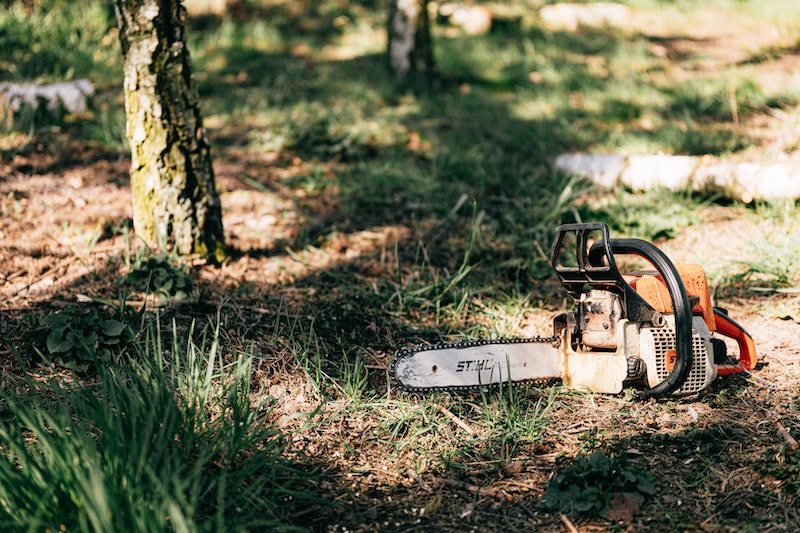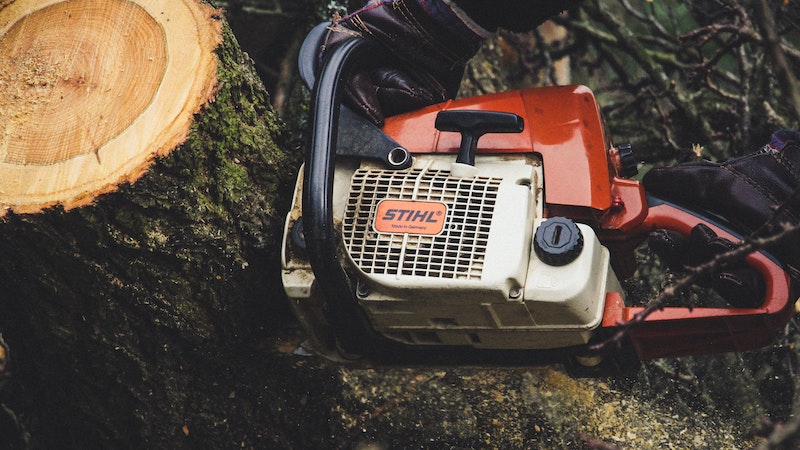
We all know what a chainsaw looks like – and what one sounds like when in action – and we know they’re used for chopping trees, logs and wood. Once they were only used in commercial situations – by a tree surgeon or in forestry – but now they’ve gone mainstream, and you can buy one for use in the garden. They are powerful and useful machines that can make life a lot easier, especially if you have a lot of trees or bushes on your land, but the big question is this: how does a chainsaw work?
In the article that follows we will tell you about each of the components of a chainsaw, what they do, and how they work with each other, and we hope to do so in simple terms that a layman can understand. So, here’s the section on the components of a chainsaw.
Components of a Chainsaw
Before we explain what each component of a chainsaw typically does, let’s list them, so we know what we are talking about. They are:
- Starting mechanism
- Engine or Motor
- Crankshaft
- Gear wheels
- Chain assembly
- Chain brake
Now you’ll recognise that a few of those are similar to terms you’ll have heard relating to a car or vehicle. They are both mechanical items, so that’s no surprise. Now let’s see what each of the above does individually, and as part of the process.
Starting mechanism – the starter mechanism does as its name says, and physically starts the Motor. This is done by a pull-cord type of starter on gas-powered models, or by an electric starter on electric-powered models.
Engine or Motor – this is self-explanatory. When you pull the cord or flick the switch, the Motor will spring to life, just as when you turn the key in your car ignition. The chainsaw is now ready to go.
Crankshaft – this is the part that the engine or motor powers, and it takes power to the gear wheels which regulate the speed of the chain.
Gear Wheels – these transfer the power and movement from the crankshaft to the chain assembly, which is the part that does the cutting.
Chain Assembly – taking the energy from the gear wheels, the chain assembly now begins to spin at high speed, allowing it to drive the cutting teeth.
Chain Brake – one of the most important parts of the chainsaw is the chain brake, and we will talk about this and the chain assembly in more detail below.
So, there you have the basics of the chainsaw and how it operates, and you understand the sequence of events. Users may sometimes have problems with chainsaws not cutting correctly. So here’s a troubleshooting guide if it’s not cutting straight. We need to cover a couple of things in more detail, but before we do, there’s one question that is often asked by people looking for a chainsaw, and it is: why are there two different types of power source? Let’s have a look at this in more detail now.
Gas vs Electric
Originally the standard power source for a chainsaw would have been a gas-powered engine. This would be a small-capacity engine, usually of two-stroke design, that gave enough power to push the chain at high speed. Gas engines are still popular with larger and commercial chainsaws as they do provide great amounts of power, but they are also high maintenance.
Electric chainsaws have come about thanks to developments in the world of electric motors and rechargeable batteries. Not all electric chainsaws use a rechargeable battery as some have a power cord that needs to be plugged into the mains. Motors differ in power but are by and largely maintenance-free, making this the saw of choice for domestic use.
Now we need to talk about the chain assembly itself, what it does and why you need to take care of it.

What is the Chain Assembly?
The chain assembly is the main part of a chainsaw, the bit that does the work. You can read some excellent reviews of affordable chainsaws at Traditional Gardening which should give you a better idea of what is available in your budget range, and what you need to consider in terms of power and size.
If you look at a chainsaw, you’ll see the chain goes around the outside of a long metal bar and hooks to teeth across the duration. When the gears engage, the chain is driven and begins to spin at high speed. This is what provides the cutting action – both kinetic energy and sharp teeth – and it is a supremely effective way of cutting through wood. You will find different sizes of a chainsaw – the popular domestic ones are either 16” or 18” – so it is worth looking at a few before you make a choice.
One other area of chainsaws we have to think about is safety. These are potentially lethal devices that, if used incorrectly, can cause considerable injury and even fatality. You must always use the chainsaw as instructed, and never let children near one. This inherent danger is also why the chainsaw will incorporate a Chain Brake.
The brake will usually take the form of a ‘dead man’s handle’; this is where the brake is always on unless it is released manually. Generally, you will find a pull-handle that needs to be put into place before the saw will operate, and that activates the brake if released. So, if the user loses control of the saw or drops it, the chain will stop in an instant. Such safety features are essential on powerful tools such as this, and we suggest you make sure any such chainsaw you use has an operable and working brake.
You will find a chainsaw is a great way of cutting down on the work and time required, and if you are indulging in gardening as therapy we promise you’ll also find it very satisfying! Check out the different models available right now, have a look at them closely and choose one in your budget, and tackle those bigger jobs you’ve been putting off!